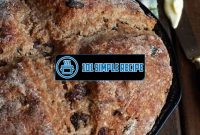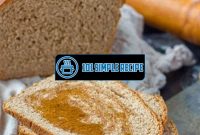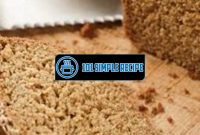Are you looking for a delicious new recipe to try? Look no further than this mouthwatering Homemade Sweet Potato Bread! This recipe is sure to become a new favorite in your kitchen, combining the natural sweetness of sweet potatoes with the comforting taste of freshly baked bread. Whether you’re a seasoned baker or a novice in the kitchen, you’ll find this recipe easy to follow and incredibly rewarding. By the end of this article, you’ll be ready to gather your ingredients and start baking your own batch of this amazing bread! ✨

Choosing the Perfect Sweet Potatoes
When it comes to making delicious homemade sweet potato bread, choosing the perfect sweet potatoes is key. The type of sweet potato you use can greatly impact the flavor, texture, and overall success of your bread. To ensure your sweet potato bread turns out amazing every time, it’s important to understand the different varieties and how to select the freshest sweet potatoes. Let’s dive in and discover all you need to know about choosing the perfect sweet potatoes for your bread.
Understanding the Different Varieties
Sweet potatoes come in various varieties, each with its unique characteristics and flavor profiles. The two main types of sweet potatoes you’ll encounter are orange-fleshed and white-fleshed sweet potatoes.
The orange-fleshed sweet potatoes, also known as “moist” sweet potatoes, tend to be sweeter and have a moist texture. These varieties, such as the Beauregard and Jewel, are ideal for creating a rich and sweet sweet potato bread.
On the other hand, the white-fleshed sweet potatoes, like the Hannah or Japanese, have a drier and more crumbly texture. While these varieties are not as sweet as the orange-fleshed ones, they still add a unique flavor to your bread and can provide a lighter and fluffier texture.
Selecting the Freshest Sweet Potatoes
When picking out sweet potatoes for your bread, freshness is key. Look for sweet potatoes that have smooth and firm skins, without any soft spots or blemishes. The skin color can vary depending on the variety, ranging from orange to brown, but make sure it’s free from mold or discoloration.
Additionally, gently squeeze the sweet potatoes to ensure they feel firm and not too soft. Soft sweet potatoes may indicate that they are overripe and might not yield the best results when used in your bread recipe.
Remember to buy sweet potatoes that are proportionate in size, as this will ensure even cooking and consistency in your bread. It’s also a good practice to buy organic sweet potatoes whenever possible to minimize exposure to pesticides and other chemicals.
Preparing Sweet Potatoes for Baking
Before you can use sweet potatoes in your bread recipe, they need to be properly prepared. Start by scrubbing the sweet potatoes under running water to remove any dirt or impurities from the skin. You can use a vegetable brush or your hands for this step.
Once cleaned, you have the option to either bake or boil the sweet potatoes. Baking is the preferred method as it helps enhance the flavor and sweetness of the potatoes. Simply place them on a baking sheet and bake in a preheated oven at 400°F (200°C) for about 45 minutes to an hour, or until they are fork-tender.
If you’re short on time, boiling is a quicker alternative. Peel the sweet potatoes and cut them into cubes. Place them in a pot of boiling water and cook until tender, usually around 15-20 minutes. Drain the potatoes and let them cool before mashing or pureeing them for your bread recipe.
By following these guidelines for choosing the perfect sweet potatoes and properly preparing them for your bread, you’ll ensure a flavorful and delightful final product. Happy baking!
If you’re in the mood for a different type of bread, try our banana bread recipe. It’s another easy and delicious option that’s perfect for breakfast or a snack.
Gathering the Essential Ingredients
When it comes to creating a delectable sweet potato bread, gathering the essential ingredients is the first step towards success. In order to achieve a flavorful and moist bread, you will need a few key components. Let’s explore what these ingredients are and how they contribute to the overall taste and texture of the bread.
Flour and Sweet Potato Ratio
One of the most crucial aspects of making sweet potato bread is getting the right ratio of flour to sweet potato. This ratio directly affects the texture and moisture level of the bread. It is recommended to use a 1:1 ratio of flour and sweet potato puree. This ensures that the bread is neither too dry nor too dense.
When selecting the type of flour, opting for all-purpose flour provides a good balance between a light and tender crumb and a sturdy structure. If you prefer a denser and heartier bread, you can experiment with whole wheat flour or a combination of different flours such as oat flour or almond flour.
Additional Ingredients for Enhanced Flavor
While sweet potatoes bring a natural sweetness and moisture to the bread, incorporating additional ingredients can elevate the flavor profile even further.
Spices: Adding warm spices like cinnamon, nutmeg, and ginger can impart a pleasant aroma and make your sweet potato bread more festive. These spices complement the natural sweetness of the potatoes, creating a harmonious blend of flavors.
Nuts and dried fruits: For added texture and bursts of flavor, consider adding a handful of chopped nuts such as walnuts or pecans, as well as dried fruits like raisins or cranberries. These ingredients add a delightful crunch and pops of sweetness to each bite.
Sweeteners: Depending on your preference, you can adjust the sweetness of the bread by incorporating different types of sweeteners. Brown sugar, honey, or maple syrup can all be used to enhance the overall taste. Just remember to adjust the amount of liquid in the recipe accordingly if you decide to use a liquid sweetener.
Exploring Gluten-Free and Vegan Options
If you have dietary restrictions or simply want to experiment with different variations of sweet potato bread, there are gluten-free and vegan options available.
Gluten-free: To make a gluten-free version of sweet potato bread, substitute the all-purpose flour with a gluten-free flour blend. There are numerous options available in stores or you can create your own blend using a combination of rice flour, almond flour, and tapioca flour. Keep in mind that gluten-free bread may have a slightly different texture compared to its traditional counterpart.
Vegan: For a vegan sweet potato bread, replace dairy ingredients such as milk and butter with plant-based alternatives. You can use almond milk or coconut milk instead of regular milk, and coconut oil or vegetable oil instead of butter. This adaptation allows those following a vegan lifestyle to enjoy a delicious sweet potato bread without compromising their dietary choices.
To sum it up, gathering the essential ingredients for sweet potato bread involves finding the perfect flour to sweet potato ratio, incorporating additional ingredients to enhance flavor, and exploring gluten-free and vegan options for those with dietary restrictions. With these key components, you are well on your way to creating a flavorful and moist sweet potato bread that is bound to become a new favorite recipe.
If you’re looking for other delicious recipes, you might enjoy our sweet potato casserole recipe. It’s a perfect side dish to complement your sweet potato bread.
Preparing the Sweet Potato Puree
Learn how to create a smooth and creamy sweet potato puree as the base for your bread.
Boiling vs. Roasting the Sweet Potatoes
When it comes to preparing sweet potato puree, you have two main options: boiling or roasting the sweet potatoes. Each method has its own advantages and can result in a delicious puree for your bread.
If you choose to boil the sweet potatoes, start by peeling and cubing them into small pieces. Then, place the sweet potato cubes in a pot of boiling water and cook until they are fork-tender. Boiling the sweet potatoes helps retain their natural flavors while also making them easier to mash.
On the other hand, roasting the sweet potatoes can bring out their natural sweetness and add a caramelized flavor to the puree. To roast the sweet potatoes, preheat your oven to 400°F (200°C). Scrub the sweet potatoes clean, pierce them with a fork, and place them on a baking sheet. Roast for about 45-60 minutes, or until the sweet potatoes are tender. Let them cool before peeling off the skin and mashing them.
Mashing and Blending Techniques
Once you have your cooked sweet potatoes, it’s time to turn them into a smooth puree. There are several mashing and blending techniques you can use to achieve the desired consistency.
One popular method is using a potato masher or fork to mash the cooked sweet potatoes until they become smooth and lump-free. This technique allows you to have more control over the texture of the puree.
If you prefer a smoother and creamier puree, you can use a blender or food processor. Simply transfer the cooked sweet potatoes into the blender or food processor and blend until you reach the desired consistency. Adding a small amount of liquid, such as milk or water, can help achieve a silky smooth texture.
Storing and Freezing Sweet Potato Puree
Once you have prepared your sweet potato puree, you may find yourself with leftovers or want to make a large batch in advance. In these cases, proper storage and freezing techniques are essential to maintain the quality of the puree.
To store sweet potato puree, transfer it into an airtight container and keep it in the refrigerator. It can stay fresh for up to 5 days. When you’re ready to use the puree, simply take it out of the fridge and give it a stir to restore its smoothness.
If you want to freeze sweet potato puree for longer-term storage, divide it into smaller portions and place them in freezer-safe containers or resealable bags. Make sure to label them with the date for easy reference. Frozen sweet potato puree can last for up to 3 months in the freezer. To thaw, transfer the container to the refrigerator overnight or use the defrost setting on your microwave.
With these tips and techniques, you can now confidently prepare a delicious sweet potato puree to use as the base for your homemade sweet potato bread. Enjoy the creamy texture and rich flavor that this ingredient adds to your recipe!
For a healthier alternative, check out our healthy sweet potato recipe. It’s a great option if you’re watching your weight or trying to incorporate more nutritious ingredients into your meals.
Mixing and Baking the Bread
When it comes to baking homemade sweet potato bread, following a step-by-step guide is crucial for achieving the perfect bake. The process involves a few key steps, including incorporating the sweet potato puree, mixing the dough, and carefully considering the baking time and temperature recommendations.
Incorporating the Sweet Potato Puree
The first step in this delectable sweet potato bread recipe is incorporating the sweet potato puree. This ingredient adds moisture and a rich flavor to the bread. To make the puree, you’ll need cooked sweet potatoes. Peel and mash them until you have a smooth consistency. You can also use canned sweet potato puree if you prefer.
Next, mix the sweet potato puree with the other wet ingredients, such as eggs, vegetable oil, and vanilla extract. Incorporating the puree thoroughly will ensure that its sweet and creamy taste is evenly distributed throughout the bread. This will give your bread that irresistible sweet potato flavor.
Tips for Mixing the Dough
To achieve the perfect texture for your sweet potato bread, it’s important to pay attention to how you mix the dough. Start by combining the dry ingredients in a separate bowl, including flour, sugar, baking powder, cinnamon, and salt.
Once the dry ingredients are mixed, create a well in the center and pour in the wet mixture. Use a wooden spoon or rubber spatula to gently fold the ingredients together until just combined. Be careful not to overmix, as this can result in a dense and tough bread. A few lumps in the batter are perfectly fine and will add a delightful texture to your loaf.
If you want to elevate your sweet potato bread to the next level, consider adding some mix-ins. Chopped nuts, such as pecans or walnuts, can provide a delightful crunch. You can also incorporate raisins, dried cranberries, or chocolate chips for an extra burst of sweetness.
Baking Time and Temperature Recommendations
When it’s time to bake the sweet potato bread, it’s important to follow the recommended time and temperature guidelines. Preheat your oven to 350°F (180°C) and grease a loaf pan to prevent sticking.
Pour the batter into the prepared pan and smooth the top with a spatula. Bake for approximately 50-60 minutes, or until a toothpick inserted into the center comes out clean. The exact baking time may vary depending on your oven, so keep a close eye on the bread during the final minutes of baking.
Once the sweet potato bread is baked to perfection, remove it from the oven and let it cool in the pan for about 10 minutes. Then, transfer it to a wire rack to cool completely before slicing and serving. The aroma of freshly baked sweet potato bread will fill your kitchen, and you’ll be tempted to devour a slice right away!
With this step-by-step guide, you’re well on your way to creating a mouthwatering sweet potato bread that will become a new favorite in your household. Enjoy the process of mixing and baking, and savor the delightful flavors of this homemade treat!
Enhancing the Sweet Potato Bread
When it comes to making homemade sweet potato bread, there are numerous ways to enhance the flavor and texture of this delightful treat. By adding creative variations and unique ingredients, you can take your sweet potato bread to a whole new level. In this article, we will explore different ways to elevate your bread, from adding nuts and seeds for crunchy texture to experimenting with sweet and savory mix-ins and spices. Get ready to embark on a culinary adventure and discover the secrets to making the most delicious sweet potato bread.
Adding Nuts and Seeds for Crunch
If you want to add some extra texture to your sweet potato bread, consider incorporating nuts and seeds into the recipe. Not only do they provide a satisfying crunch, but they also offer additional nutritional benefits. Walnuts, for example, are packed with healthy fats and antioxidants. By gently folding in a handful of chopped walnuts into your batter, you can create a delightful contrast of flavors and textures. Pumpkin seeds and flaxseeds are other great options that add a nutty flavor and a delightful crunch to your bread. To add an emoji, let’s go with , representing the nuts we are adding into the sweet potato bread.
Exploring Sweet and Savory Mix-Ins
One way to elevate the taste of your sweet potato bread is by exploring a variety of sweet and savory mix-ins. Consider incorporating ingredients like dried fruits, such as cranberries or raisins, to add a burst of sweetness and chewiness to your bread. For a savory twist, you can try adding crumbled feta cheese or chopped olives. The combination of sweet and savory flavors creates a unique and irresistible taste. Remember, the mix-ins you choose can be tailored to suit your personal preferences, so feel free to get creative! Let’s add an emoji here to represent the mix-ins, how about to represent the dried fruits and to represent the feta cheese.
Experimenting with Spices and Seasonings
To truly elevate the flavor profile of your sweet potato bread, don’t be afraid to experiment with a variety of spices and seasonings. Cinnamon, nutmeg, and ginger are classic choices that complement the natural sweetness of the sweet potatoes. These warm and aromatic spices add depth and complexity to your bread. Additionally, you can experiment with unconventional combinations such as adding a pinch of cayenne pepper for a subtle kick or incorporating a hint of cardamom for a unique twist. Remember to start with small amounts and adjust according to your taste preferences. For an emoji representation, let’s go with ️ for the cayenne pepper and for the spices and seasonings we are experimenting with.
By enhancing your sweet potato bread with nuts and seeds, exploring sweet and savory mix-ins, and experimenting with spices and seasonings, you can create a truly remarkable and mouthwatering treat. Don’t be afraid to get creative and modify the recipe to suit your taste preferences. The possibilities are endless, and you might just stumble upon your new favorite sweet potato bread recipe. Happy baking!
Thank you for taking the time to read our sweet potato bread recipe. We hope you found it helpful and delicious. Don’t forget to bookmark our site and visit again later for more mouthwatering recipes. Happy baking!
Frequently Asked Questions
Here are some common questions about our sweet potato bread recipe:
| No. | Questions | Answers |
|---|---|---|
| 1. | Can I use canned sweet potato instead of fresh? | Yes, you can use canned sweet potato as a substitute. Just make sure to adjust the measurements accordingly. |
| 2. | Can I add nuts or raisins to the bread? | Absolutely! Feel free to add your favorite nuts or raisins to the bread batter for an extra flavor and texture. |
| 3. | How long does the bread stay fresh? | The sweet potato bread can stay fresh for up to 3-4 days if stored in an airtight container at room temperature. |
| 4. | Can I freeze the bread? | Yes, you can freeze the sweet potato bread. Wrap it tightly in plastic wrap or place it in a freezer bag before freezing. Thaw it in the refrigerator overnight before enjoying. |
| 5. | Can I make this recipe gluten-free? | Yes, you can substitute the all-purpose flour with a gluten-free flour blend to make it a gluten-free sweet potato bread. |
| 6. | Can I use honey instead of sugar? | Yes, you can replace the sugar with honey. Keep in mind that honey is sweeter than sugar, so adjust the amount accordingly. |
Thank You for Reading
We appreciate your time and interest in our sweet potato bread recipe. We hope you have a great baking experience and enjoy every delicious slice. Remember to visit our website again for more fantastic recipes. Happy baking!
Jump to Recipe
Sweet Potato Bread Recipe

Try our delightful sweet potato bread recipe, perfect for a cozy breakfast or afternoon snack. Made with wholesome ingredients and a hint of cinnamon, this bread is moist and full of flavor. Follow our easy step-by-step instructions to create this delectable treat at home.
- 2 cups all-purpose flour
- 1 teaspoon baking soda
- 1/2 teaspoon salt
- 1/2 teaspoon cinnamon
- 1 cup mashed sweet potato
- 1/2 cup unsalted butter (melted)
- 1 cup granulated sugar
- 2 large eggs
- 1 teaspoon vanilla extract
- 1/2 cup milk
- Preheat the oven to 350°F (175°C). Grease a 9×5-inch loaf pan and set aside.
- In a large bowl, whisk together the flour, baking soda, salt, and cinnamon until well combined.
- In a separate bowl, mix together the mashed sweet potato, melted butter, sugar, eggs, vanilla extract, and milk until smooth.
- Pour the wet ingredients into the dry ingredients and stir until just combined. Be careful not to overmix.
- Transfer the batter into the greased loaf pan. Smooth the top with a spatula. Bake for 55-60 minutes, or until a toothpick inserted into the center comes out clean.
- Remove the bread from the oven and let it cool in the pan for 10 minutes. Then, transfer it to a wire rack to cool completely before slicing and serving.






